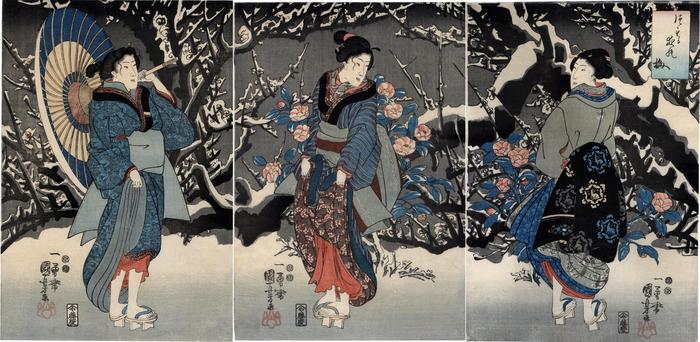Utagawa Kuniyoshi (歌川国芳) (artist 11/15/1797 – 03/05/1861)
Triptych of Plum Blossoms in the Evening Snow (Tsumoru yo no ume - つもる夜の梅)
1846 – 1848
30.7 in x 14.5 in (Overall dimensions) Japanese color woodblock print
Signed: Ichiyūsai Kuniyoshi ga
一勇斎国芳画
Artist's seal: kiri (in red)
Publisher: Fujiokaya Keijirō (Marks 063 - seal 21-026)
Censor's seals: Muramatsu and Yoshimura
Tokyo National Diet Library - items #43-45
Museum of Fine Arts, Boston - center and right panel only from a later and crudely printed edition
Minneapolis Institute of Arts
Art Gallery of New South Wales - center panel only
Tokyo National Diet Library - another album - items #30-32
National Diet Library - items #43-45 Both Toyokuni III and Kuniyoshi designed triptychs of elegant women in elegant kimonos standing before a backdrop of dramatically, almost preternatural, blossoming leafless plum trees. The beauty is both stark and eye-catching.
Toyokuni III created at least four of these gorgeous compositions and Kuniyoshi five. However, there are probably more examples by both men. This particular lay out holds its own against any earlier masterpieces by the best of the best ukiyo-e artists.
Although most of these triptychs were published by different houses, thematically the form a unified set, in the loosest sense of the term. (JSV)
****
A problem solved: the setting is the Crawling Dragon Plum
Timothy Clark wrote about another Kuniyoshi triptych "The 'Crawling Dragon Plum' (Garyūbai) seen here was a famous attraction of Umeyashiki, a garden located close to the Tenjin shrine at Kameido in Honjo district... The trunk of this ancient tree had tilted over onto the ground, where it continued to push down the roots, the twisting, constantly proliferating shape prompting it poetic name. Plum was one of the earliest blossoms to appear each spring, and delicate flowers emerging from rugged old trees formed a powerful symbol of renewal. The fragrance of the thousands of blossoms on the Crawling Dragon Plum was almost overpowering and Umeyashiki was always thronged with visitors of all classes at this time of year...
Kuniyoshi and other ukiyo-e artists produced several versions of the subject, typically featuring one beautiful woman on each sheet of a triptych with the trunk and branches executed across the back with bravura ink-strokes... Painting plum trees gave Chinese, Korean and Japanese artists - particularly the 'scholar-painters' (bunjin) - a chance to show off their brush skills. Sometimes they deliberately split brush hairs so as to suggest gnarled trunks and spiky branches, a technique skilfully imitated here by Kuniyoshi and his block-cutter."
Quoted from: Kuniyoshi from the Artur R. Miller Collection by Timothy Clark, p. 159. (JSV)
****
The 'Crawling Dragon Plum' (Garyūbai), sometimes referred to as the 'Reclining Dragon Plum', or even 'the Sleeping Dragon Plum', was the most famous tree in the Edo region. Located at Komeido, Edoites would go out to see it every year and to be engulfed in it fragrance. Hiroshige created a design in 1858 showing only one part of this tree in his '100 Famous Views of Edo' series. It shows a flowering, vertical tree trunk in the foreground, with a lot of flowering plum trees behind it. The whole area was fenced off by the time of this print in 1858 to keep the garden safe from visitors. It turns out that all of those other trees being shown were actually part of the one main branch which had given this famous tree its name, Garyūbai (臥龍梅). Van Gogh did a very famous copy in oil of this Hiroshige. The tree was lost to a flood in 1880 and a plaque was placed in its spot to commemorate it. (JSV)
****
The National Diet Library curatorial notes state specifically that this triptych dates from 1848.
****
There is another copy of this triptych at the Shimada Museum of Art. There is also another copy of the far right panel in the Canterbury Museum, Christ Church, New Zealand, but there is totally different, much brighter coloration and therefore must come from a different edition. It creates a whole different mood.
****
Mike Lyon noticed that while looking at this triptych and comparing it to the two panels in the collection in Boston that the two sheets in the Museum of Fine Arts lacks Kuniyoshi's red paulownia seal. Of course, this is another argument for the late nature of the Boston edition of their prints.
Fujiokaya Keijirō (藤岡屋慶次郎) (publisher)
beautiful women (bijin-ga - 美人画) (genre)
